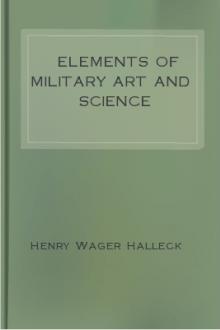Elements of Military Art and Science by Henry Wager Halleck (books you have to read txt) 📕

- Author: Henry Wager Halleck
- Performer: -
Book online «Elements of Military Art and Science by Henry Wager Halleck (books you have to read txt) 📕». Author Henry Wager Halleck
This system of defence for our Northern frontier has been much commented on by men professing some knowledge of the military art, and various opinions have been advanced respecting its merits. Some have thought that more and larger works should be placed on the western extremity of this line; others attach by far the greatest importance to the central or Montreal portion of the frontier; while others, again, attach a higher value to the eastern extremity of the line.
These last would have us concentrate our main forces on the head-waters of the Kennebec and the Penobscot, and then advance upon Quebec, a distance of some 250 miles, along the isolated carriage-road, through the valley of the Chaudiere. Here is only a single road, but little travelled, and penetrating a wide and almost uninhabited wilderness. General Jomini says emphatically, that a line of operations should always offer two or three roads for the movement of an army in the sphere of its enterprises,—an insuperable objection to the Kennebec route, except as a diversion to the main attack. But there are still stronger objections to this route, than its want of feasibility for the transportation of the main army; for even should that army succeed in reaching Quebec in safety, the expedition would be entirely without military results, unless that fortress could be immediately reduced,—a contingency which would be extremely doubtful under the most favorable circumstances; and even should we be ever so fortunate in our operations, the siege of such a place would occupy a considerable length of time. It would be throwing our forces along the most difficult line of operations, against the strongest point in the enemy's line of defence, and making the success of the whole plan depend upon the contingency of a reduction, in a few days, of one of the strongest fortresses in the world. What principle in military science would justify such a plan of campaign? We are fully aware of the great advantages to be derived from the reduction of Quebec; and we are also aware of the great difficulties to be encountered in any attempt to accomplish that object. It may, and probably will ere long, be made to surrender to our arms; but it would be utter folly to base our military operations on the contingency of a short and successful siege. By advancing upon Montreal by the Lake Champlain route, we could cut off the Canadian forces in the West from all reinforcements; and then, as circumstances might direct, could besiege Quebec, or attack the enemy in the field, or perhaps, manœuvring as the French did at the siege of Mantua, accomplish both objects at the same time.
We have seen that it was one of Napoleon's maxims that an army should choose the shortest and most direct line of operations, which should either pierce the enemy's line of defence, or cut off his communications with his base. It is the opinion of men of the best military talent in our army that the Lake Champlain line satisfies all these conditions at the same time;—that it is the most direct, most feasible, and most decisive line which can be pursued in case of operations against Canada; and that it is indispensable to success in war that this line be well fortified in time of peace. All agree that the St. Lawrence above Quebec constitutes the key point of the enemy's defence, and the objective point towards which all our operations should be directed. To reach this point, all our Boards of Engineers have deemed it best to collect our troops at Albany and advance by Lake Champlain, a distance of only two hundred miles. Besides the advantages of a good water communication the whole distance for the transportation of military stores, there are several roads on each side, all concentrating on this line within our own territory. It has already been shown by the brief sketch of our northern wars, that this line has been the field of strife and blood for fifteen campaigns. Nature has marked it out as our shortest and easiest line of intercourse with Canada, both in peace and war. Military diversions will always be made on the eastern and western extremities of this frontier, and important secondary or auxiliary operations be carried on by the eastern and western routes; but until we overthrow the whole system of military science as established by the Romans, revived by Frederick and practised and improved by Napoleon, the central and interior line, under all ordinary circumstances, will furnish the greatest probabilities of success.
If the line of Lake Champlain is, as we have endeavored to show, the most important line in the north; its security by fortifications is a matter of the greatest interest. The works recommended by the Board, consist of a single fort, costing $600,000, at Rouse's Point, on the extreme frontier, and unfortified dépôts at Plattsburg and Albany. But is this sufficient to accomplish the object? If the hostile army should pass the extreme frontier barrier, what is to retard his advance,—what defensive works are to protect the débouché of the Northern canal, or even to save the great central dépôt? We know of no foreign engineer who has recommended less than three lines of fortifications for the security of a land frontier; and Napoleon, the Archduke Charles, and General Jomini, agree in recommending at least this number of lines. There may be circumstances that render it unnecessary to resort to a three-fold defence throughout the whole extent of our northern frontier; but upon our main line of communication with Canada,—a line of maximum importance both to us and to the enemy, we know of no reason for violating the positive rules of the art,—rules which have been established for ages; and sanctioned by the best engineers and greatest generals of modern times.
Ticonderoga has more than once stayed the waves of northern invasion; and we know of no change in the art of war, or in the condition of the country, that renders less important than formerly the advantages of an intermediate point of support between Albany and the Canadian lines. Indeed it would seem that the connection of the Hudson with the lake by the northern canal had even increased the value of such a point.
It would seem, moreover, that the great value of a central dépôt near Albany would warrant a resort to the best means of security which can be afforded by defensive works. Here we already have one of our largest arsenals of construction; here are to be located magazines for the collection and deposit, in time of peace, of gunpowder; here, in time of war, is to be formed the grand military dépôt for our whole northern armies; and here is the point of junction of the lines of communication of our northern and eastern states, and the great central rallying point where troops are to be collected for the defence of our northern frontier, or for offensive operations against Canada. Such a place should never be exposed to the coup-de-main of an enemy. The chance operations of a defensive army are never sufficient for the security of so important a position. We do not here pretend to say what its defences should be. Perhaps strong têtes-de-pont on the Mohawk and Hudson rivers, and detached works on the several lines of communication, may accomplish the desired object; perhaps more central and compact works may be found necessary. But we insist on the importance of securing this position by some efficient means. The remarks of Napoleon, (which have already been given,) on the advantages to be derived from fortifying such a central place, where the military wealth of a nation can be secured, are strikingly applicable to this case.
But let us look for a moment at what is called the western plan of defence for our northern frontier.
Certain writers and orators of the western states, in their plans of military defence, would have the principal fortifications of the northern frontier established on Lake Erie, the Detroit river, the St. Clair, and Lake Huron; and the money proposed for the other frontier and coast works, expended in establishing military and naval dépôts at Memphis and Pittsburg, and in the construction of a ship-canal from the lower Illinois to Lake Michigan,—for the purpose of obtaining the naval control of the northern lakes.
It is said that British military and steam naval forces will ascend the St. Lawrence to Lake Ontario; that to counteract these operations we must build an opposition steam-navy at Pittsburg and Memphis, and collect out troops on the Ohio and Mississippi, ascend the Mississippi and Illinois, Lake Michigan, Lake Huron, and the Georgian Bay, cross over to the Ottawa by French river and Lake Nipissing, or Moon river and the Muskago, then descend the Ottawa river to Montreal. But as there might be some difficulty in conveying their war-steamers over some twelve or fifteen portages between the Georgian Bay and the Ottawa, and as the upper waters of that river are not navigable by such craft, it has, by some of the military writers before alluded to, been deemed preferable to descend Lake Huron, St. Clair river and lake, run the gauntlet past the British forts on the Detroit, descend Lake Erie and the Niagara[26] into Lake Ontario, so as to meet the English as they come steaming up the St. Lawrence!
[26]
How they are to pass the Falls was not determined either by Harry Bluff or the Memphis Convention.
It is agreed upon all sides that the British must first collect their forces at Quebec, and then pass along the line of the St. Lawrence and Lake Ontario to reach the Niagara and Detroit frontiers. Our boards of engineers have deemed it best to collect troops on the Champlain line, and, by penetrating between Montreal and Quebec, separate the enemy's forces and cut off all the remainder of Canada from supplies and reinforcements from England. But it has been discovered by certain western men that to cut the trunk of a tree is not the proper method of felling it: we must climb to the top and pinch the buds, or, at most, cut off a few of the smaller limbs. To blow up a house, we should not place the mine under the foundation, but attach it to one of the shingles of the roof! We have already shown that troops collected at Albany may reach the great strategic point on the St. Lawrence by an easy and direct route of two hundred miles; but forces collected at Pittsburg and Memphis must pass over a difficult and unfrequented route of two thousand miles.
Our merchant marine on the lakes secures to us a naval superiority in that quarter at the beginning of a war; and our facilities for ship-building are there equal if not superior to any possessed by the enemy. The only way, therefore, in which our ascendency on the lakes can be lost, is by the introduction of steam craft from the Atlantic. The canals and locks constructed for this object will pass vessels of small dimensions and drawing not over eight and a half feet water.
How are we to prevent the introduction of these Atlantic steamers into our lakes? Shall we, at the first opening of hostilities, march with armed forces upon the enemy's line of artificial communication and blow up the locks of their ship-canals, thus meeting the enemy's marine at the very threshold of its introduction into the interior seas; or shall we build opposition steam-navies at Pittsburg and Memphis, some two thousand miles distant, and then expend some forty or fifty millions[27] in opening an artificial channel to enable them to reach Lake Ontario, after its borders have been laid waste by the hostile forces? Very few disinterested judges would hesitate in forming their opinion on this question.[28]





Comments (0)